Swiss Meringue Buttercream
A deep dive into SMBC and a tonne of troubleshooting!
Alright, let’s get going on our first buttercream deep dive. I’ve already covered the basics of Swiss meringue buttercream (SMBC) and how it differs from other buttercreams in this post. And if you’re not a fan of buttercream, I also have a huge cream cheese icing deep dive which you can read here.
Swiss meringue is definitely my most used buttercream, it’s easy, it’s delicious and it’s adaptable. I really think anyone can make SMBC, even with absolutely no baking experience, so please don’t be nervous if you’ve never tried it before.
I already have loads recipes in the recipe archive using SMBC and this week we’re adding to them with a recipe for a very simple yet delicious jammy layer cake. This recipe is exclusively for paid subscribers, if that sounds like something you’re into, please consider becoming a paid subscriber. You’ll receive an exclusive recipe every week, plus access to the full archive of over 100 thoroughly tested cake and dessert recipes. And you'll be helping support me so I can continue creating and sharing recipes! 🩷
It’s just £6 a month or £60 for a whole year. To subscribe or upgrade, just hit the button below and join me for more recipes and general baking chats!
I think the best way to get started is by taking a look at really simple Swiss meringue buttercream recipe. This base recipe is completely plain so feel free to add whatever flavours you like. A big glug of vanilla extract is a good place to start.
Swiss Meringue Buttercream - Base Recipe
150g egg whites
300g caster sugar
Pinch of salt
450g soft, unsalted butter
Heat a pan of water to just below a simmer.
Combine the sugar and egg whites in a heat proof bowl and whisk together (I just use the bowl of my stand mixer to save washing up).
Place over the pan of just simmering water and whisk until the egg white and sugar mixture reaches about 70°C/158°F. You don’t have to worry about incorporating air at this point, the stand mixer will do that later, for now we’re just whisking to make sure the egg doesn’t start to cook.
Transfer to a stand mixer and whisk on high until the meringue reaches stiff peaks and is cool to the touch.
Add the salt followed by the soft butter a chunk at a time, despite what some recipes say, you don’t need to do this slowly, you can even add it all at once if you like.
When the butter has all been added, leave to whisk for a further 5 minutes until the buttercream is very pale, soft and fluffy. It should melt in your mouth when you eat it.
The buttercream is now ready to add your flavourings and use!
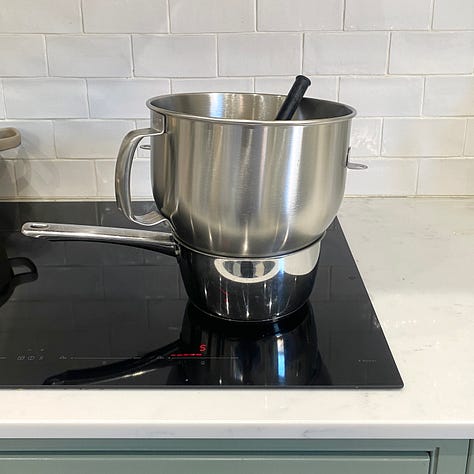
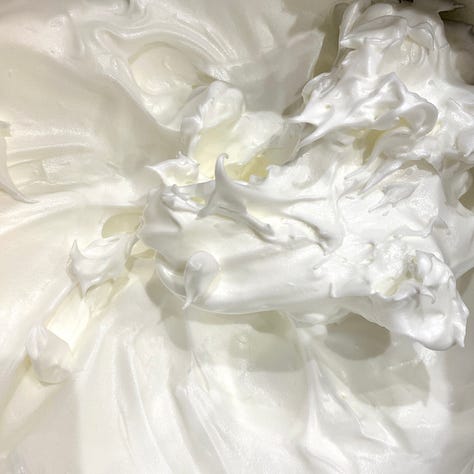
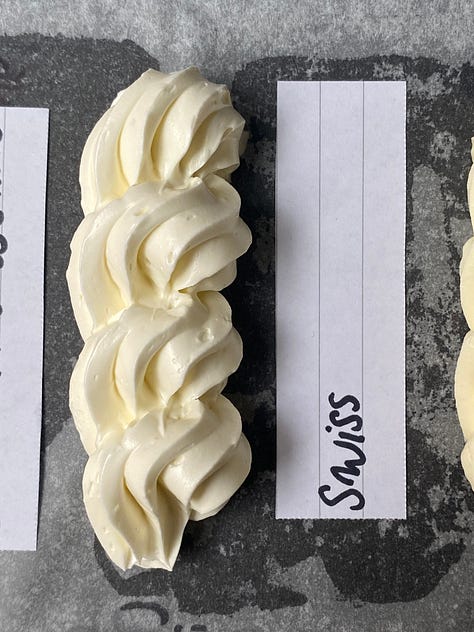
1 bain-marie, 2 meringue at stiff peaks, 3 finished buttercream
Troubleshooting
In this area of troubleshooting I’m going to focus on getting the perfect texture for filling and piping, the texture that we need for a perfect silky smooth finish isn’t quite the same, we’ll get onto this later. If you’re not bothered about getting a super smooth finish then all of these tips will still work well and you can go ahead and use this buttercream for both the filling and the outside of your cake. Apologies in advance if this section gets slightly repetitive, you’d be amazed how many problems can be fixed just by whisking the sh*t out of buttercream.
Split buttercream - This is the problem that I see most often and actually has the easiest fix - just keep whisking! Some people like to switch to a paddle attachment when adding the butter but my preference is to stick with the whisk until the buttercream is fully emulsified. Even the most curdled, buttercream can be saved by just giving it a good whisk! My other tip is to gently warm your buttercream before re-whisking, this helps to soften the butter making it easier to emulsify with the egg whites. You can do this by gently blowtorching the outside of your mixing bowl as the buttercream whisks. Alternatively, you can warm the buttercream by microwaving 1/3 of the buttercream in 20 second bursts until very soft, or, if you don’t have a microwave, you can put it back over the bain-marie, just keep an eye on it or you’ll end up with buttercream soup.
Hard/buttery buttercream - Again, my solution for this is to gently warm the buttercream and re-whisk. If your butter is too cold, it will be more difficult to incorporate any air meaning that your buttercream will taste much more dense and buttery as well as being difficult to spread. SMBC can take a lot of whisking so don’t be afraid to just keep on whisking if the texture is a bit dense and buttery, when you use it, it should be almost white, soft and super fluffy.
Sloppy buttercream - My kitchen is absolutely freezing, even in the summer months so luckily this isn’t a problem that I encounter too often but if you’re in a warm kitchen buttercream can get sloppy quickly. If this happens, don’t worry! Just chill the buttercream in the fridge for at least 30 minutes and then re-whisk it, if it’s still sloppy, you’ll need to chill it for longer.
Accidentally cooked egg whites - Look, we’ve all been here, I’m absolutely terrible for walking away from my bain-marie. If this happens and you have a few lumpy, cooked bits of egg white don’t panic, just sieve the egg whites and sugar mixture to remove the lumps of cooked egg, re-weigh what you have left and add however much extra white and sugar you need, luckily the rations of white to sugar are 1:2 so this should be fairly easy to work out.
Meringue didn’t reach stiff peaks - This can happen if some fat is introduced, for example if there’s a bit of egg yolk in the white or the mixing bowl has a bit of greasy residue left on it. This is a potentially controversial opinion but I hate waste and I think, as long as your meringue has a bit of volume to it you can go ahead and add your butter (soft peaks or even ribbon stage is fine). The buttercream is more likely to split at first but as long as you carry on whisking it, it will come together eventually, just be patient. However if you’re egg whites are still completely soupy with very little volume, even after whisking for at least 5 minutes, you might have to throw them away and start again.
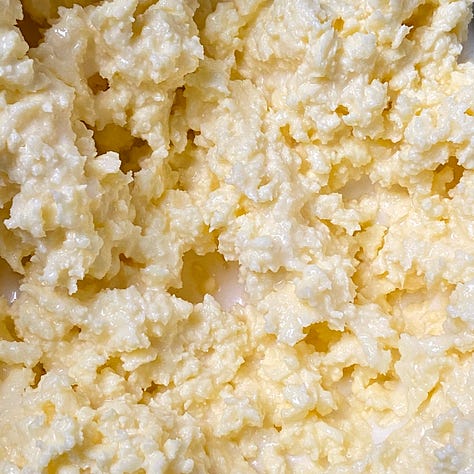
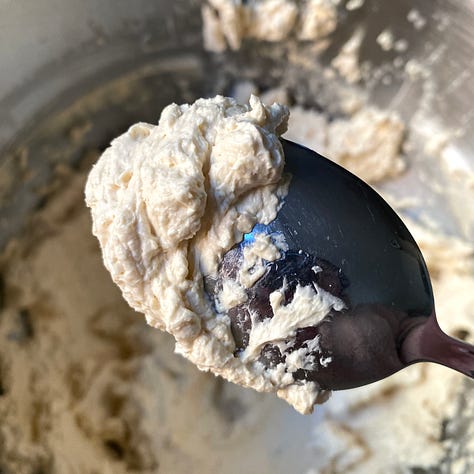
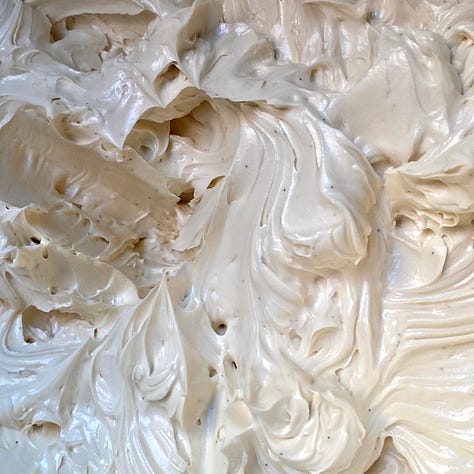
1 split buttercream, 2 dense buttercream, 3 perfect buttercream
If you’ve ever had any other problems when making buttercream please let me know and I’ll add them to the troubleshooting section. I’m continually updating newsletters so that they contain as much information as possible!
The Ratios
A lot of baking involves sticking very closely to strict ratios but there’s a bit of wiggle room here and you can add more or less butter depending on the texture you like. The ratio I’ve shared above is a 1:2:3 ratio, 1 part egg white, 2 parts sugar, 3 parts butter, this suits my preferences but you can alter the recipe to your tastes or depending on what you’re making.
You can add more or less butter to suit your preferences, a 1:2:2 ratio will give you a very light, fluffy buttercream that’s on the sweeter side, this buttercream will be more difficult to smooth and you won’t be able to add much liquid flavourings (e.g. fruit puree) at the risk of it splitting but this is a good option if you find a buttercream too “buttery”.
You can also up the butter to a 1:2:4 ratio. This buttercream will be extremely smooth and easy to work with and there’s greater potential to add liquid flavourings without it splitting, I use this ratio when making my cream cheese Swiss meringue buttercream or when I’ll be adding a lot of praline paste to a buttercream.
You can also reduce or increase the sugar, although take care as less sugar makes a less stable meringue meaning that there will be an increased risk of splitting and a denser final buttercream. I wouldn’t reduce it by more than 20%.
Adding Flavours
When it comes to adding flavours there are loads of ways of doing it, here are just a few of my favourites:
Sugars - One of my favourite ways to change up the favour of my buttercreams is by using different sugars, with SMBC it’s best to stick to granular sugars rather than runny sugars like honey, we’ll cover these in another deep dive! The caster sugar can be swapped out for any granular sugar you like, if I’m making something like coffee or chocolate buttercream I tend to use light brown sugar, if I want a dark, treacly flavour I use dark brown or muscovado sugar, this is great paired with brown butter, I use this combination for my sticky toffee pudding cake (free recipe).
Liquids - There are loads of options when it comes to adding liquids; fruit puree, espresso, curd, alcohol etc. Swiss meringue buttercream can take quite a lot of liquid add-ins, I find that when it comes to runnier liquids like coffee or alcohol, the maximum you can add is around 15% of the total weight of the buttercream. always taste it as well! For thicker liquids like purees or curds, you can add up to 20% - 25% of the total weight of the buttercream. I add blackcurrant puree to flavour my blackcurrant and earl grey stripe cake (free recipe). Don’t just use these figures without tasting though! Different add-ins will require different quantities.
Other - The possibilities really are endless when it comes to flavouring, you can use zest, extracts freeze dried powders and more. You don’t really need to worry about ratios here so just go for it! One of my favourite methods of adding a toasty flavour is toasting the meringue before adding the butter. I use the toasted meringue method for my lemon meringue pie cake (paid recipe).
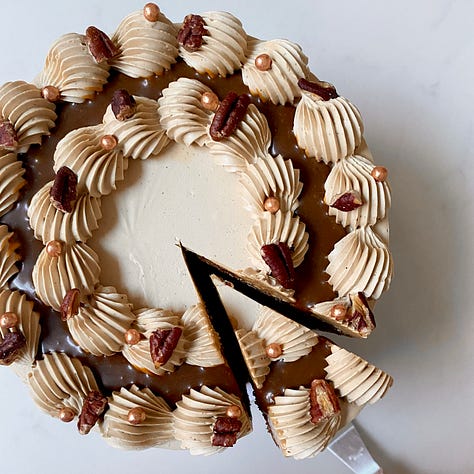
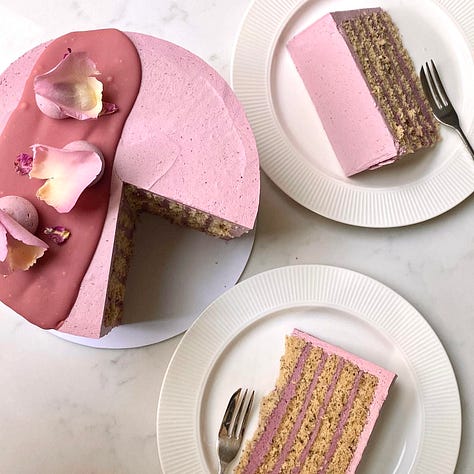
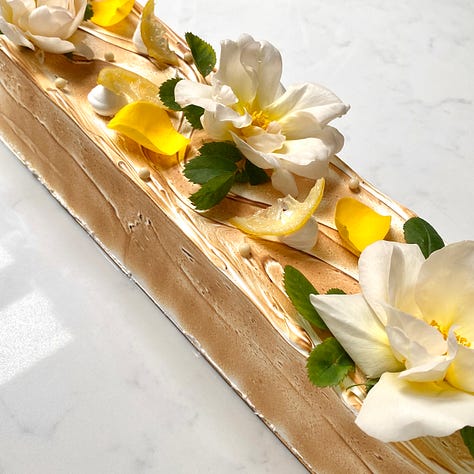
How To Use SMBC
The obvious answer to this is to dollop copious amounts into a cake and then into your mouth but there is some nuance when it comes to working with SMBC.
The ultimate texture that you want when it comes to eating SMBC is light, fluffy and full of air. However this isn’t the ideal texture for the outside of your cake, especially if you want a silky smooth finish and crisp edges. When getting a smooth finish on a cake air bubbles are your enemy and you want as few as possible. So here’s how I tackle this…
When using buttercream for filling and crumb coating a cake, make the buttercream exactly as above, the best temperature for filling cakes is room temperature (around 18°C or 65°F), I don’t tend to check the temperature, I usually go off the look and feel of the buttercream but if you’re not sure it doesn’t hurt to check!
For coating cakes the buttercream needs to be warmer, around 24°C or 75°F. I usually heat 1/3 of it in the microwave then add the warm buttercream back into the rest of the batch rather than heating the full amount to avoid going overboard and melting my entire batch. Once warm enough, beat the buttercream on the lowest speed with a paddle attachment, this will burst the larger air bubbles leaving your buttercream the perfect consistency to use on the outside of a chilled cake.
When it comes to piping, I prefer to pipe with cooler buttercream but either are ok! These temperatures and techniques apply to almost all buttercreams including Italian, American and whole egg.
Storage
In the fridge buttercream can be stored for up to a week, before using it you’ll need to re-whisk it. If you’re in a cold kitchen you might need to gently warm it before whisking.
I find the best way to store buttercream in the freezer is in a sandwich bag, I squish it down, freeze it flat and then you can easily stack it with other buttercreams or ganaches. To use it you’ll need to let it completely defrost in the fridge before re-whipping.
I think that’s all I have to say about Swiss meringue buttercream for now! Thank you so much for joining me. If you enjoyed this post and want to support my work please like, comment or share! It really helps my newsletter to grow so that I can continue to create and share free content. Thank you so much! 🩷



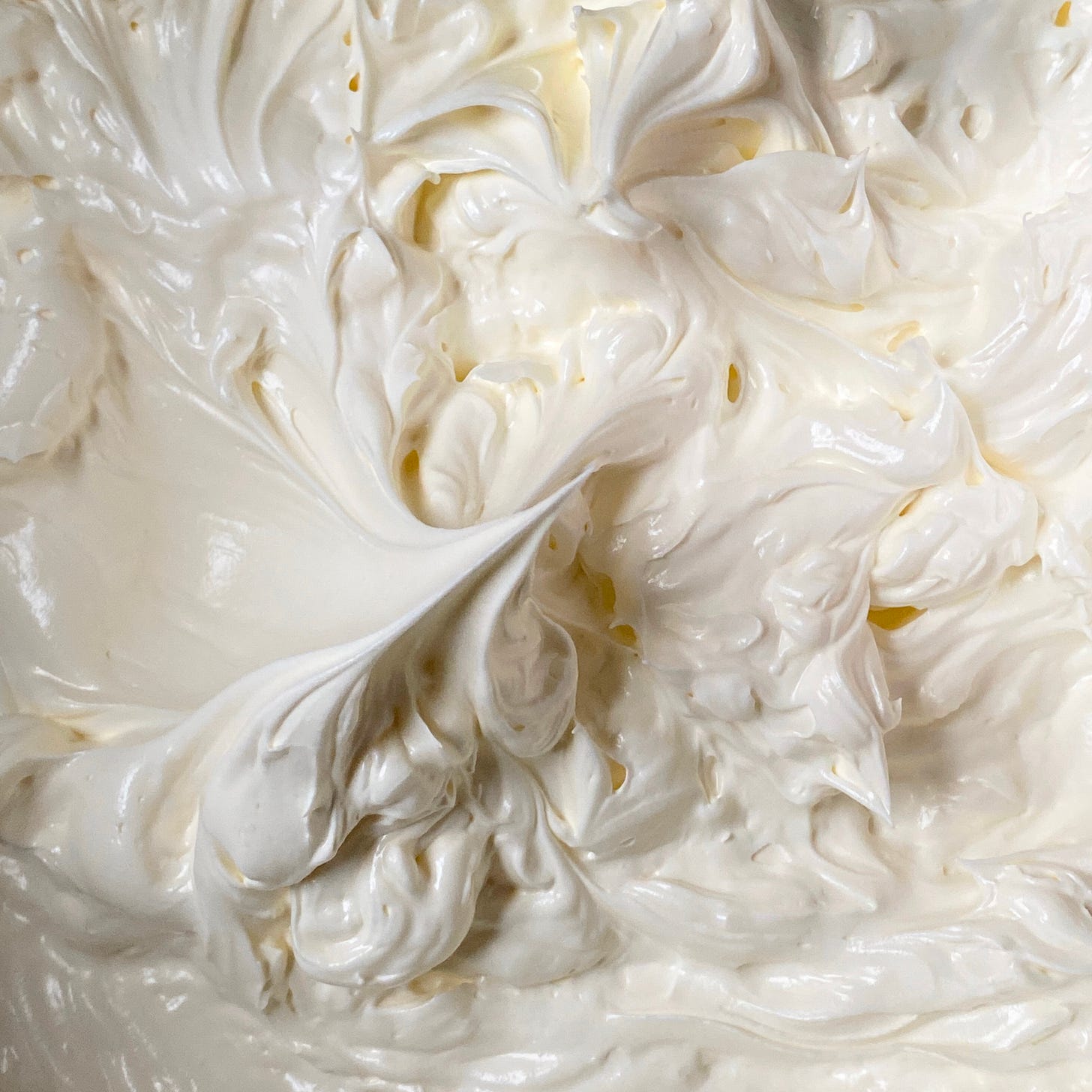
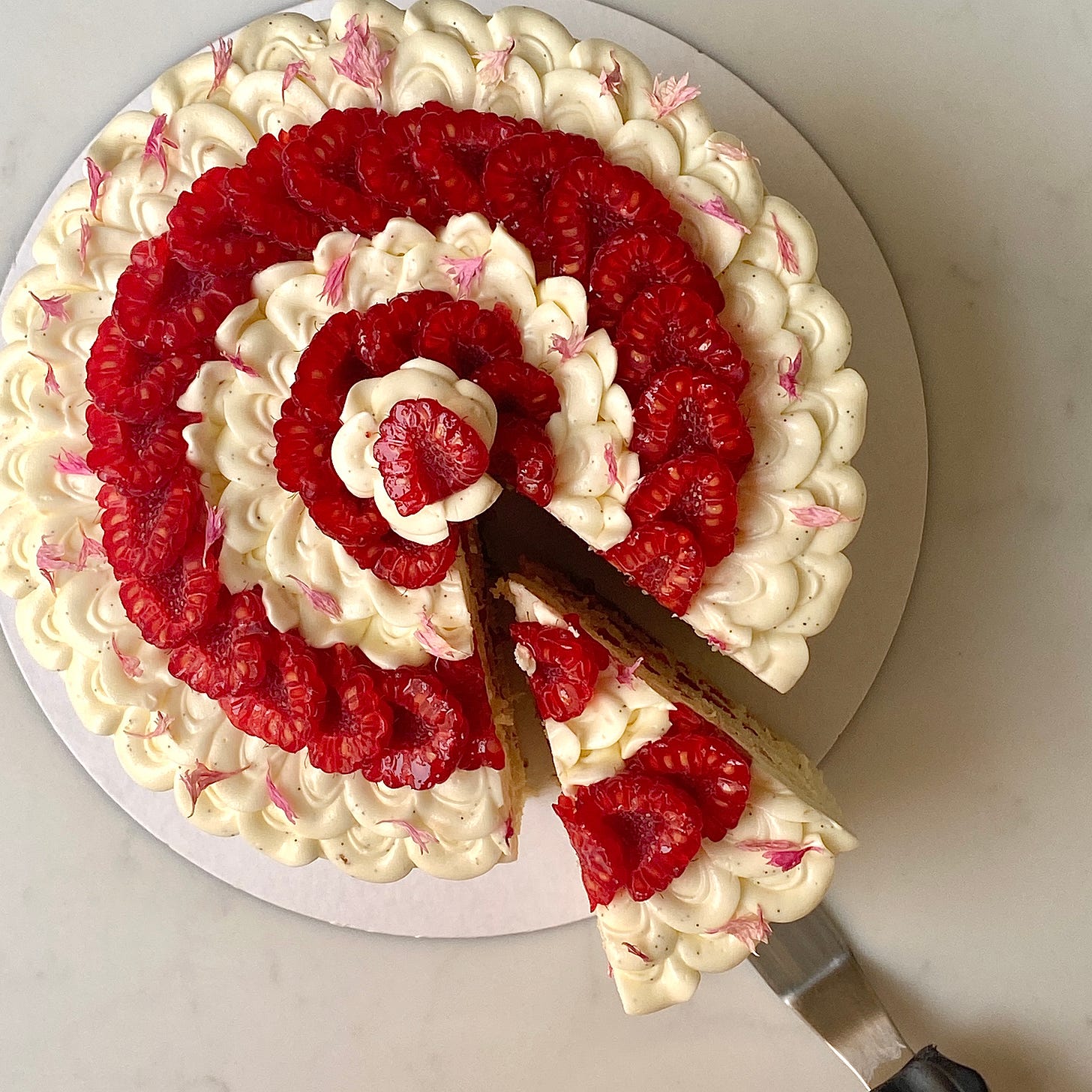
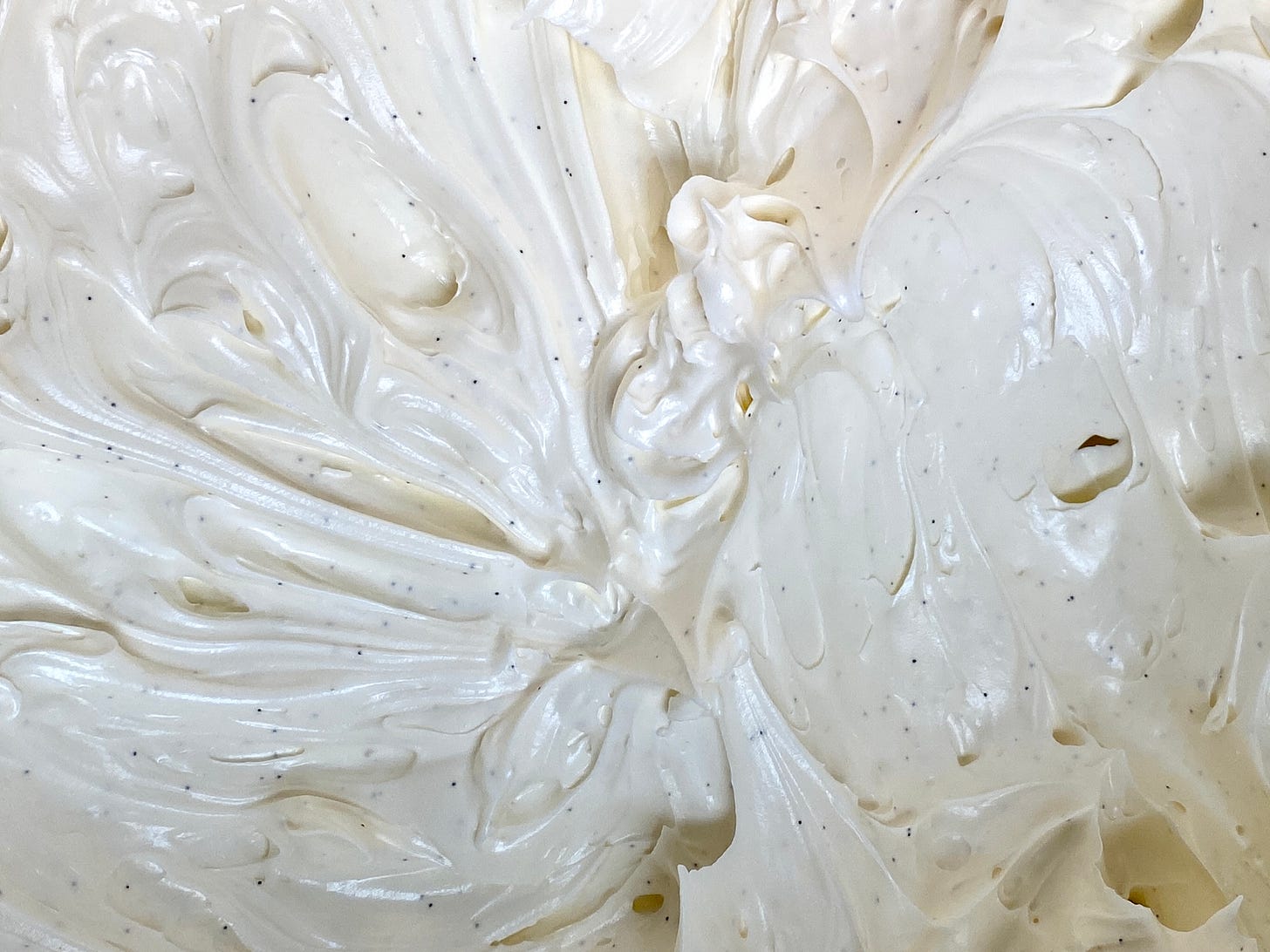
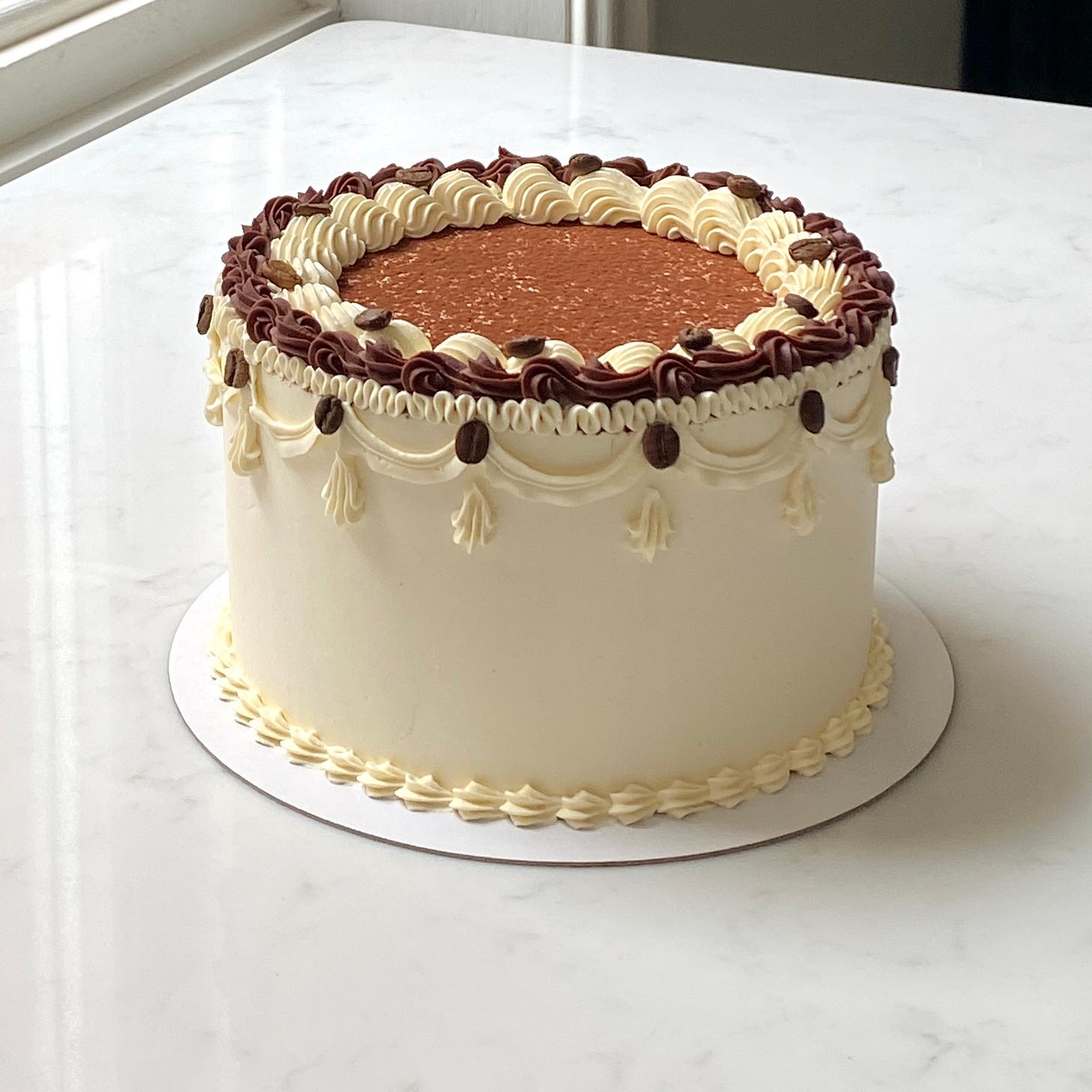
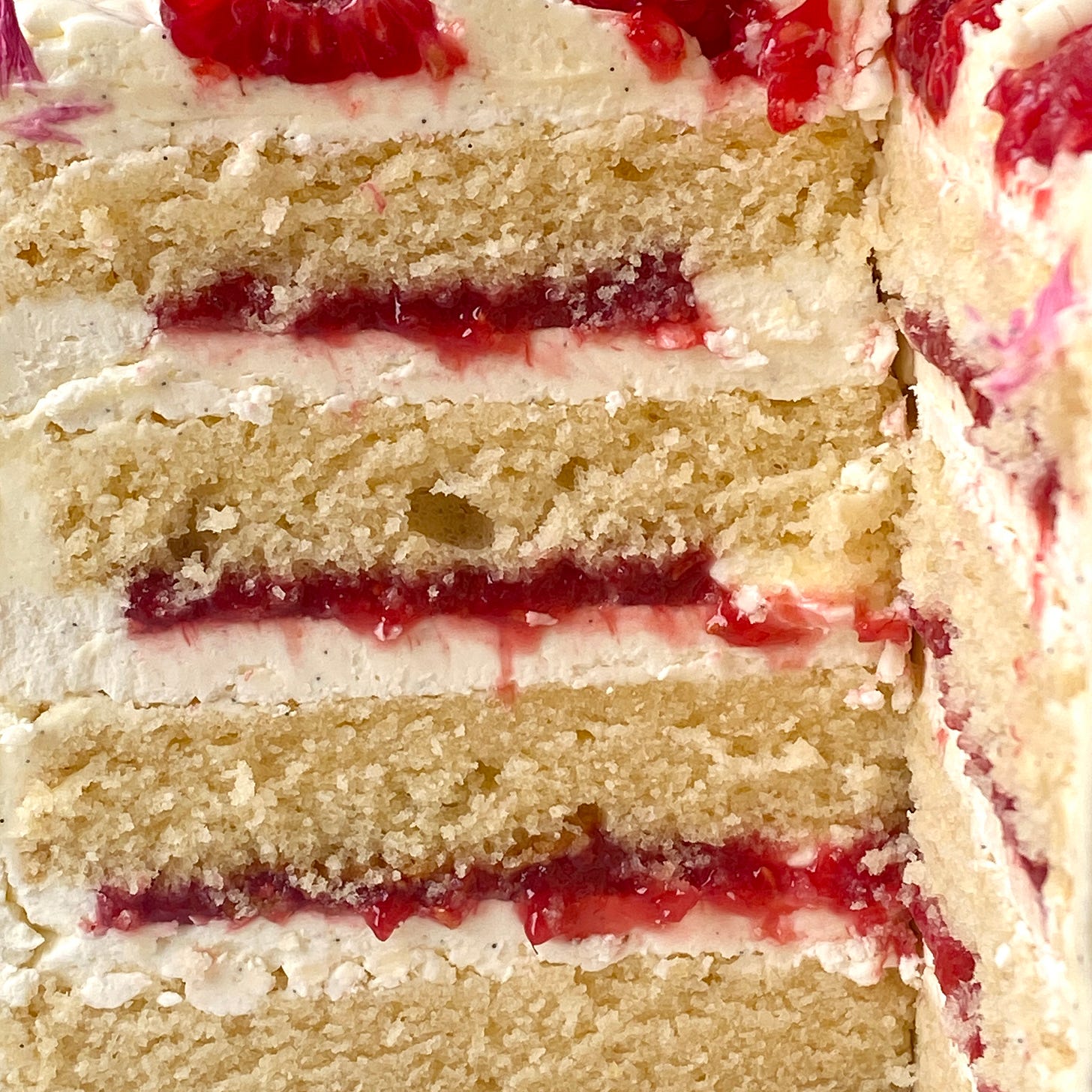
hi!! i made caramel for the first time using your recipe, and I very slightly burnt the first batch (second one was perfect though!) so I was thinking of adding it to buttercream. how would I go about this? would I use the same ratio as when adding praline? thank you!!
Thank you for this post,
I have been asked for a chocolate cake which I will use your Bruce chocolate cake recipe
(always a success!) but wanted to swap out the chocolate ganache outside for a white chocolate SMBC as I need to decorate it with a train.
Do you think this is possible? I was trying to see in your posts if you had a chocolate SMBC to try, I also know that white chocolate does not always act in the same way. Any advice on this would be amazing.
Thank you x